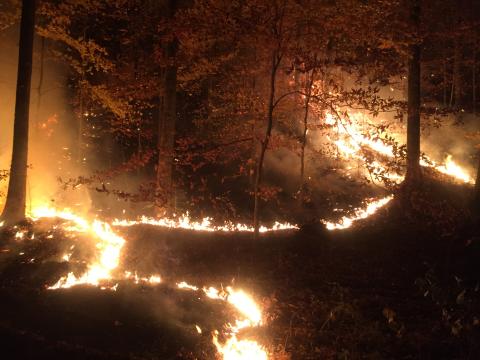Living with Fire

Wildfire moves through the forest by consuming the fuel in front of it, which could include homes in woods unless precautions are taken.
Steve Roark
Volunteer Cumberland Gap National Historical Park
With Forest Fire season now in play thought it good to review our relationship with fire and how to get along with it. We live on a planet where carbon chemically reacts with oxygen at a high enough temperature to produce heat energy and light, a chemical process we call “fire”. The carbon is produced by plants like trees and grass. Since almost any plant material can burn, fire is a very common phenomenon, doing either harm or good depending on where and what it consumes.
Fire can be seen as good when it is used as a tool, such as burning brush piles or leaves. It can be used to prepare a site for tree planting by removing woody debris or improve some wildlife habitats. It remains good as long as it stays where it belongs and burns only what is intended. Keeping it good requires planning and management, a process we call prescribed fire. Fire becomes bad when it burns things unintended, what we call wildfire. Wildfire lives only to consume fuel and it does not care if the fuel is leaves on the ground or a building. So if your home is located in on near a forest, fire will treat it like any other fuel and burn it if it can get to it and under the right conditions.
Many of us like being close to nature and so building a home in a forest or other wild places is understandable. There’s a catchy name for houses built in the woods: the Wildland Urban Interface, or WUI for short.
Here’s the deal: a forest drops tons of dead leaves, needles, twigs, branches, even entire trees (all carbon remember) every year. This dead material is what fuels a wildfire and allows it move around. A house in the woods receives some of this deluge of dead fuel, and if allowed to can accumulate on the lawn, in flower beds, against the foundation, and even in gutters and on roofs. So a wildfire could burn right up to the house and potentially ignite it. Floating embers (called fire brands) produced by the fire could land in a leaf filled gutter or roof and start them ablaze as well.
So bottom line: folks that live in the woods need to be proactive in protecting their home from wildfire. Actions to take are common sense things: keep leaves raked up near the home; keep gutters and roofs clean, use non-flammable mulching material next to the house (not bark), don’t plant flammable landscape plants near the house. The goal is to keep your house and landscape in such a condition that it would withstand a wildfire even if no one was around.
There is a national educational program called Firewise that provides excellent advice on how to keep homes safe from wildfire. Contact your local state forestry agency for more information, or go online to www.firewise.org.
- Log in to post comments